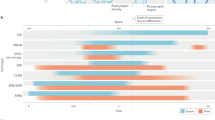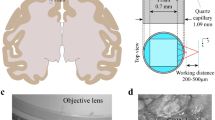Abstract
The glucose analogue 2-deoxyglucose (2-DG) can be used quantitatively to measure metabolic activity1 and is widely used qualitatively for mapping functional activity in the brain2–4. The resolution (meaning the full width at half maximum of the grain density distribution around a line source) of the technique using [14C]-2-DG and X-ray film is limited to about 100 µm5. Attempts have been made to improve the resolution using [3H]-2-DG (ref. 6) and cellular resolution has been achieved in the goldfish retina7 and with cultured mouse neurones8. An anatomical technique for mapping the metabolic activity of individual neurones would be useful for studying invertebrate central nervous systems, which are relatively simple and stereotyped compared to vertebrate brains. The [3H]-2-DG technique was applied to an invertebrate in a study of the Drosophila visual system9, though without cellular resolution. We present here modifications of the [3H]-2-DG technique to demonstrate localization of 2-DG in single neurones of Limax maximus, a gastropod mollusc, with a resolution of less than 1 µm.
This is a preview of subscription content, access via your institution
Access options
Subscribe to this journal
Receive 51 print issues and online access
$199.00 per year
only $3.90 per issue
Buy this article
- Purchase on Springer Link
- Instant access to full article PDF
Prices may be subject to local taxes which are calculated during checkout
Similar content being viewed by others
References
Sokoloff, L. et al. J. Neurochem. 28, 897–916 (1977).
Hubel, D. H., Wiesel, T. N. & Stryker, M. P. Nature 269, 328–330 (1977).
Des Rosiers, M. H. et al. Science 200, 447–449 (1978).
Kelley, D. B. Science 207, 553–555 (1980).
Goochee, C., Rasband, W. & Sokoloff, L. Ann. Neurol. 7, 359–370 (1980).
Des Rosiers, M. H. & Descarries, L. C. r. hebd. Séanc. Acad. Sci., Paris D 287, 153–156 (1978).
Basinger, S. F., Gordon, W. C. & Lam, D. M. K. Nature 280, 682–684 (1979).
Ornberg, R. L. et al. J. Cell Biol. 83, 142a (1979).
Buchner, E., Buchner, S. & Hengstenberg, R. Science 205, 687–688 (1979).
Feder, N. & Sidman, R. L. J. biophys. biochem. Cytol. 4, 593–600 (1958).
Gelperin, A., Chang, J. J. & Reingold, S. C. J. Neurobiol. 9, 285–300 (1978).
Reingold, S. C. & Gelperin, A. J. exp. Biol. 85, 1–19 (1980).
Stirling, C. E. & Kinter, W. B. J. Cell Biol. 35, 585–604 (1967).
Van Harrevald, A., Crowell, J. & Malhotra, S. K. J. Cell Biol. 25, 117–137 (1965).
Henkart, M. P., Reese, T. S. & Brinley, F. J. Jr Science 202, 1300–1303 (1978).
Reingold, S. C. et al. (submitted for publication).
Chang, J. J. & Gelperin, A. Proc. natn. Acad. Sci. U.S.A. 77 (in the press).
Author information
Authors and Affiliations
Rights and permissions
About this article
Cite this article
Sejnowski, T., Reingold, S., Kelley, D. et al. Localization of [3H]-2-deoxy glucose in single molluscan neurones. Nature 287, 449–451 (1980). https://doi.org/10.1038/287449a0
Received:
Accepted:
Issue Date:
DOI: https://doi.org/10.1038/287449a0
This article is cited by
-
Ultrastructural metabolic activity following quick-freezing and freeze-substitution in tetrahydrofuran in the superior cervical ganglion
Journal of Neurocytology (1989)
-
The determination of the local cerebral glucose utilization with the 2-deoxyglucose method
Histochemistry (1988)
-
Autoradiographic measurement of tritiated agmatine as an indicator of physiologic activity inHermissenda visual and vestibular neurons
Journal of Neurocytology (1986)
-
Deoxyglucose mapping of nervous activity induced inDrosophila brain by visual movement
Journal of Comparative Physiology A (1984)
-
Localization of Functional Activity in the Central Nervous System by Measurement of Glucose Utilization with Radioactive Deoxyglucose
Journal of Cerebral Blood Flow & Metabolism (1981)
Comments
By submitting a comment you agree to abide by our Terms and Community Guidelines. If you find something abusive or that does not comply with our terms or guidelines please flag it as inappropriate.



